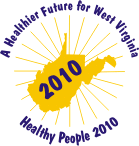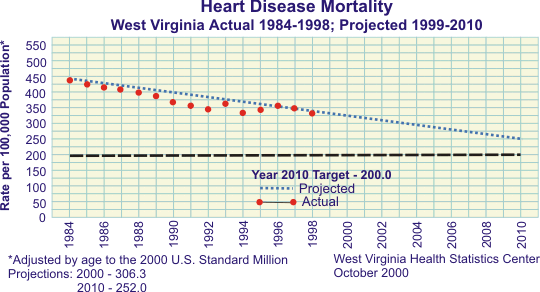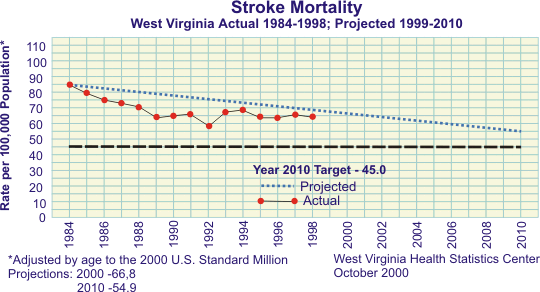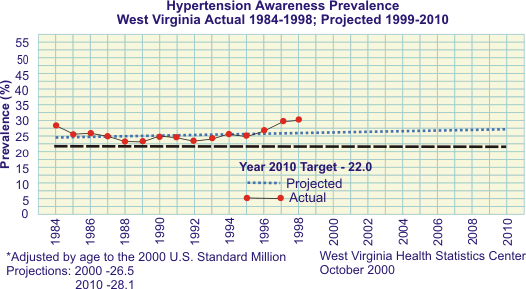A Healthier Future for West Virginia - Healthy People 2010
Federal 2010 Initiative
|
Contents Message Credits Objectives |
|
| 1 2 3 4 5 6 7 8 9 10 11 12 13 14 15 |
16 17 18 19 20 21 22 23 24 25 26 27 28 29 |

12 - Heart Disease and Stroke
Background
Heart disease has not been conquered. Although we've won a few battles against heart disease, we are still losing the war. Dramatic technological and medical advances are saving and extending the lives of people with heart disease, but not curing them of it. As a result, more people are living with heart disease than ever before. While medical intervention is important in managing heart disease, a more effective strategy would be preventing heart disease in the first place.
Heart disease continues to be the leading cause of death in both the United States and West Virginia, while stroke continues as the third leading cause of death. Together they account for approximately 40% of all deaths.
Population-based prevention is the next strategy to win the war against heart disease. Prevention includes widely promoting heart-healthy lifestyle changes to the total community and creating social, environmental, and policy changes that support heart health.
People's individual lifestyle choices are partly mediated by their environments, including policies that help shape their environments. Access to safe walking areas, open recreation facilities in every community, clean indoor air policies, and the availability of low-cost, healthy, good-tasting foods are critical to helping people make the decision to embrace physical activity, a tobacco-free lifestyle, and a heart-healthy diet. In addition, ensuring that preventive health protocols are established and reimbursed through third party payers is instrumental to the prevention of cardiovascular disease. We must increase opportunities for healthy behaviors by creating policies in our community systems, health care systems, and other systems that support the promotion of health.
Top of PageThe Objectives
FLAGSHIP OBJECTIVE
OBJECTIVE 12.1. Reduce heart disease mortality to no more than 200 deaths per 100,000 population. (Age-adjusted Baseline: 323.5 in 1998)
Data Source: West Virginia Bureau for Public Health (WVBPH), Office of Epidemiology and Health Promotion (OEHP), Health Statistics Center (HSC)

Since 1950, age-adjusted death rates from cardiovascular disease (CVD) have declined 60%. However, the overall decline masks important differences in death rates by race/ethnicity, sex, socioeconomic status, and geographic region. In addition, risk factors for heart disease such as obesity and physical inactivity are at an all-time high (see Chapter 19: Nutrition & Overweight and Chapter 22: Physical Activity & Fitness).
OBJECTIVE 12.2. Reduce stroke deaths to no more than 45 per 100,000 population. (Age-adjusted Baseline: 59.1 in 1998)
Data Source: WVBPH, OEHP, HSC

Stroke is a cardiovascular disease that affects the blood vessels supplying blood to the brain. It is one of the leading causes of serious, long-term disability. Death rates for heart disease and stroke from 1986-95 were higher among African Americans in West Virginia than among Caucasians.
OBJECTIVE 12.3. Decrease the proportion of adults who have high blood pressure to no more than 22%. (Baseline: 28.3% in 1997)
Data Source: WVBPH, OEHP, Behavioral Risk Factor Surveillance System (BRFSS)

High blood pressure, or hypertension, affects more than 50 million Americans and is a major cause of heart disease, stroke, complications of diabetes, and heart and kidney failure. Hypertension is a complex mix of environmental and genetic factors. It is not known exactly how many causal factors there are or how they interact with each other. However, based on present knowledge, high blood pressure and its sequelae can be controlled effectively.
African-American Behavioral Risk Factor Survey respondents interviewed from 1992-96 in West Virginia were more likely (40.5%) to report having high blood pressure than either Caucasians in West Virginia (26.7%) or African Americans in the nation as a whole (31.0%).
OBJECTIVE 12.4. Increase to at least 75% the proportion of adults who have had their blood cholesterol checked within the preceding 5 years. (Baseline: 67.2% in 1997)
DataSource: WVBPH, OEHP, BRFSS
At least 39% of the coronary heart disease in the United States is attributable to elevated total cholesterol (or hypercholesterolemia). Hypercholesterolemia is a major risk factor for coronary heart disease, which leads to heart attack.
OBJECTIVE 12.5. Reduce the mean serum cholesterol level among adults to no more than 193 mg/dl. (Baseline: 202.56 mg/dl in 1999)
Data Source: PEIA Pathways to Wellness Program
The Public Employees Insurance Agency (PEIA) Pathways to Wellness Program is working to promote healthier lifestyles for every PEIA member. There are currently over 100 public worksites enrolled. Health risk assessments are offered voluntarily and include cholesterol screenings.
OBJECTIVE 12.6. (Developmental) Increase by 100% from baseline the proportion of females who are aware that cardiovascular disease (heart disease and stroke) is the leading cause of death for all females. (Baseline data available from the BRFSS in 2000)
Data Source: WVBPH, OEHP, BRFSS
Cardiovascular disease, particularly coronary heart disease and stroke,
remains the leading killer of women in America and most developed countries.
In 1994, CVD claimed the lives of more than one-half million women and
accounted for 45.2% of all deaths among women, more than all forms of
cancer combined. Misperceptions still exist that CVD is not a real problem
for women, although it is estimated that one in two women will eventually
die of heart disease or stroke, compared with one in 25 who will eventually
die of breast cancer.
In February, a report released by West Virginia University and the Centers
for Disease Control and Prevention (CDC) stated that West Virginia women
suffer from far higher rates of heart disease deaths than women in other
parts of the country. West Virginia ranked 49th out of the 50 states and
the District of Columbia for heart disease mortality among women - only
New York and Mississippi suffered higher death rates than West Virginia.
Meeting the Objectives
Health Promotion Channels for Achieving Objectives:
- Worksites
- Schools
- Public Health Programs
- Networks
- Health Care System
- Higher Education
As of July 1, 1999, the West Virginia Bureau for Public Health received a Core Capacity Grant for Cardiovascular Health from the CDC. This grant will allow the Bureau to expand its program and begin to build capacity to address cardiovascular health for West Virginia. This grant is a cooperative agreement and continued funding will be contingent on federal appropriations.
Members of the Cardiovascular Health Steering Committee came together on November 3, 1999, and agreed to provide leadership for state efforts, develop and endorse the state plan, coordinate statewide activities, and assist in building public and legislative support for cardiovascular disease prevention and control efforts. Organizations represented on this Steering Committee include:
American Heart Association
Coalition for a Tobacco-Free West Virginia
Healthy People 2010 Heart Disease & Stroke Work Group
St. Mary's Regional Heart Center
West Virginia Coalition for Minority Health West Virginia Coalition for
Physical Activity West Virginia Department of Education
West Virginia Nutrition and Chronic Disease Coalition
West Virginia University (WVU) School of Medicine
West Virginia Bureau for Public Health.
To address the racial and ethnic disparities in heart disease mortality, the WV Bureau for Public Health and the West Virginia Coalition for Minority Health (comprised of individuals who live and work in the African-American community) collaborate to develop culturally appropriate strategies. This partnership has resulted in several church and community-based interventions promoting increased physical activity, good nutrition, and the elimination of tobacco use.
As systems for cardiovascular health surveillance are developed, further assessments of cardiovascular health in our state will be identified. This will enable us to assess our target audiences, develop inventories of policies and environments that promote cardiovascular health, and allow our partners to develop appropriate strategies to intervene. West Virginia's Cardiovascular Health Plan will be developed to meet the Healthy People 2010 Objectives related to the promotion of heart health. Release of the Cardiovascular Health Plan is scheduled for June 2001.
Top of PageWork Group Members
Jessica G. Wright, RN, MPH, CHES, Work Group Leader, Director
of Chronic Disease Programs, Division of Health Promotion, WVBPH
Claudia Sims, Concerned citizen
Ed Haver, MA, WV Assoc. of Cardiac and Pulmonary Rehabilitation,
Director, Cardiac Rehabilitation, Charleston Area Medical Center
Suzanne DeBrecamecker, DO, Raleigh Cancer Center
Carla See, MS, CHES, Senior Project Coordinator, Preventive Cardiology
Clinic, Department of Medicine,WVU
Sharon Boni, RN, MSN, DNSc, Chair, Division of Health and Science,
Alderson-Broaddus College
Lisa Ranson, BS, Program Manger, WV Youth Tobacco Prevention Campaign,
WV Hospital Association
William Neal, MD, Department of Pediatrics, Robert C. Byrd Health
Sciences Center, WVU
Mayur Amonkar, PhD, MS, BS, Assistant Professor, WVU School of
Pharmacy
Mary Emmett, PhD, Director, Health Education and Research Institute,
CamCare
Joan Skaggs, RN, MSN, Pediatric Nurse Educator/Community Liaison,
Office of Maternal, Child & Family Health, WVBPH
Patricia A. Crawford, Health Promotion Specialist, WV School of
Osteopathic Medicine
References/Resources
American Heart Association. High Blood Pressure Statistics. Dallas, TX: 1998.
Barnett E et al. Women and Heart Disease: An Atlas of Racial and Ethnic Disparities in Mortality. Morgantown, WV: Office for Social Environment and Health Research, West Virginia University, December 1999.
Langer R et al. Cardiovascular Disease in Women: A Statement for Health Care Professionals from the American Heart Association. Dallas, TX: American Heart Association, 1997.
Pearson T et al. "Optimal risk factor
management in the patients after coronary revascularization: a statement
for the health care professionals from an American Heart Association writing
group." Circulation 90: 3125-3133.
West Virginia Bureau for Public Health. West
Virginia Minority Health Chart Book. Charleston, WV: West Virginia
Department of Health and Human Resources, 1999.
For More Information
Cardiovascular Health Program
Office of Epidemiology and Health Promotion
Room 319
350 Capitol Street,
Charleston, WV 25301-3715
Phone: (304) 558-0644; Fax: (304) 558-1553
healthywv.org
This page was last updated June 14s, 2001.
For additional information about HP2010, contact Chuck Thayer at (304) 558-0644
or Chuck.E.Thayer@wv.gov